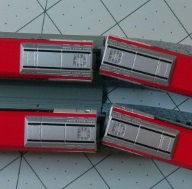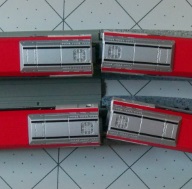I've mentioned previously that the tight radius of conventional T-Trak corners is a bit of a minus for me. While tight radii in and of themselves are one problem, there's something that really makes the module curves jarring to me: the lack of easements.
Many model railroads have a tradition of doing things very different from the twelve-inch-to-the-foot variety. Most model track is sectional, with pieces of specific lengths. For curves, they are a specific radius and angle, too. As a result, when designing layouts, we talk about curves of specific radius. Not so in the real world.
| On the Prototype |
| Surveyors used a unit of measure called the chain. In the US, this was 66 feet (22 yards, or 1/80th of a mile) though sometimes a 100-foot chain was used (usually with railroads.) When the railroads were laid out, the surveyor would plan turns using "degrees of curvature" by knowing how many degrees of turn were required. The first (and last) chain (or "station") of the curve might be 1 degree from tangent (straight ahead), while the next (and penultimate) chain might be 2 degrees from straight, and so on. Note that this would describe a 6 degree turn over those four stations. These techniques were used because it may have been impractical—or even impossible—to measure a radius from some remote center point; also, during the early days of the railroads, trigonometric calculations had to be done using tables, so any technique that eliminated this need was preferable. Nowadays, calculators make simple work of all the math, but the precedent is established. |
To understand why, imagine driving your car. As you come to a bend in the road, imagine you suddenly jerk the steering wheel the suitable amount to round the bend. With the turn completed, you jerk the steering wheel back to the straight-forward position. You've successfully made the turn, but your passengers and anything else along for the ride have just been slammed against both sides of the vehicle. Unpleasant. Needless to say, this is not how you really drive (I hope not, anyway...)
Instead, what you're likely to do is to ease into the turn, gradually turning the steering wheel as you enter the curve until you've turned the wheel as much as is necessary (that is, you're at the minimum turn radius) and then ease back out as you leave the curve. This easement is what makes the car turn more comfortably.
The effect is that you're driving a few feet at a fairly large radius (when you've just turned the steering wheel a little bit) a few more feet at a slightly tighter radius (as you're turning it more) and so on, gradually getting tighter and tighter, until you're fully in the turn. Then you're doing the opposite on the way out.
Railroads do the same thing, too. They do not jump from straight track to a fixed-radius curve. When our model trains do use a fixed radii, there's a subtle "tell" that screams "TOY!" once you see it. And just like the arrow in the FedEx™ symbol, once you know about it, you can't really pretend it's not there anymore.
That revealing tell is tail swingThis the term used by bus drivers and truckers, though it's not clear to me the same term is used on the railroads; it may not be "a thing" on the prototypes precisely because of their use of easements, and that any overhang that is experienced is accounted for in loading gauge.: the amount the end of a vehicle swings outward when making a turn. Truckers, bus drivers and even those driving RVs or have towed trailers are keenly aware of what this is, especially when their wheelbase is significantly shorter than the overall length of their vehicle. They may even have war stories to share.
On model railroads, this trait is most visible right at the start of a sudden radius curve, when one car is completely in the turn, while the adjacent car is completely on straight track. Photos here illustrate this for various radii, and as you can tell, the sharper the curve, the more pronounced the swing. When you see the ends of cars bobbing into and out of line at every curve, it really shatters the realism. (It does for me, anyway.)
This behavior happens at the junction of two significantly different radiiWhere you can consider straight track as something with infinite radius..., so the obvious fix is to put easements into your turns, so you're spreading that "instantaneous" change in radius out over some distance, preferably a car length or two. This is even possible with sectional track, assuming that enough large radius formats are available. Even just starting with a few degrees of a much larger radius will reduce that tail-swing, at the cost of needing to start the turn a bit earlier... hopefully an acceptable compromise.






 Generate a QR code link to this page
Generate a QR code link to this page